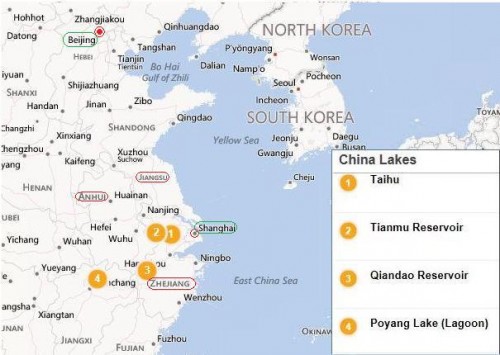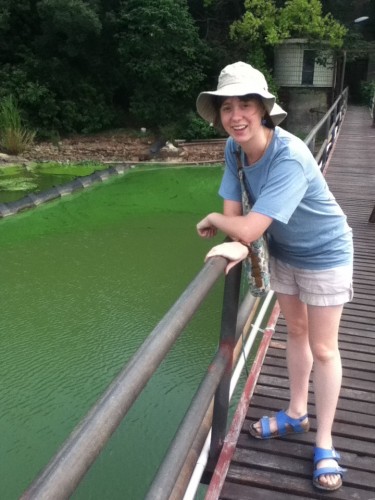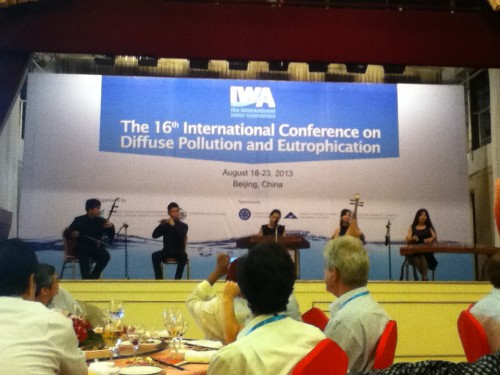????Hi all, I write to you from the Nanjing Institute for Geology and Limnology, Chinese Academy of Science, (NIGLAS). Since 1960, NIGLAS researchers have focused on understanding lake basin ecosystems in China. The Institute has also installed monitoring buoys on some of their lakes that allow it to gather lake data in real-time. As such, it is involved with the Global Lake Ecological Observatories Network, (GLEON), a grass-roots network of scientists interested in sharing their data through the web.

For the moment, I am settling in for a few stationary weeks after a whirlwind month of visiting research sites and attending a conference in Beijing. Following my landing in Shanghai, I headed to Wuxi to start my internship, at NIGLAS’ field station, Taihu Laboratory for Lake Ecosystem Research (TLLER).
There, I met a group of high school students who were on a summer excursion to learn about the lake environment. My supervisor had asked me to give them a presentation that afternoon on a topic of my choosing. I had a few hours with the students before I gave the talk, so I asked them what they wanted to hear about. They recommended I talk about “my research.”
With that in mind, I put together a simple PowerPoint presentation consisting of CMAPs about the policy gap and how it relates to Taihu. I wish I could say I gave this presentation in Chinese, but the students came from a foreign language high school, and had a pretty good handle on English, so that was the language I used. Once I finished talking, the students stumped me with their first question. They wanted to know how to persuade local government to slow down construction and take earnest responsibility for environmental issues. I gave them the best advice I could, but I also admitted that there is no easy answer to that question, and no easy solution to the problem.
***
For the following days I explored the field station and got a good whiff of the decaying algae at Taihu. For most of the 20th century, this lake was healthy, with a low nutrient content. That changed with the accelerated development China began to see in the 1970s. Intensive agriculture and increasing untreated sewage around the lake led to an increase in its nitrogen and phosphorus levels.

Over the past three decades, the lake has become highly eutrophic and is now a hub for those interested in studying toxic algae blooms. Case in point, after about a week at the field station in Wuxi, I traveled with a PhD student to Nanjing to join her in welcoming a collaborative research group from the U.S. The group was working on an array of questions relating to the microbiology and biogeochemistry of Taihu. Several of the researchers had visited Taihu every couple of years since 2002. A couple questions they discussed were:
What is the limiting nutrient?
Apparently, there is a heated debate in the scientific world about whether this is usually phosphorus or nitrogen. It is important to determine which so that you can definitively tell lake managers what measures need to be taken to clean up their lakes. This group of researchers felt that, unfortunately, nitrogen was the more important nutrient. This is unfortunate because the nitrogen cycle is much more complex than the phosphorus cycle, and much more difficult to manage.
What can be done to improve our understanding?
The use of monitoring buoys and modeling techniques can be used to understand some of the complex dynamics in a lake. By collecting continuous data, scientists get a better picture of a lake’s condition and relay that information to local officials. Local officials can make then decisions about short-term and long-term actions they need to take.
***
At the end of a week of this discourse, I traveled again with my PhD friend to Beijing to attend a conference held by the International Water Association (IWA).The topic of the conference was on Nonpoint Source Pollution and Eutrophication. Many presentations approached topics similar to what the Taihu group was looking at.
I had never before attended a conference as intensive and high-profile as this one, and now that I know what to expect, I have some advice to give anyone who is applying for jobs and internships. I know that my supervisor had mentioned the conference to me as far back as February, when I was still in the beginning stages of acquiring an internship. If I had planned ahead, I might have come up with a research project or poster idea to submit. Unfortunately, I did not think of this at the time, but in the future I will remember that it is something to pay attention to. Otherwise, the conference was very successful for me. I attended many of the presentations, made important connections, and even got some feedback on questions I have regarding my thesis.

As far as I can tell, the next few weeks will consist of building a web-site for the field station and planning surveys about the use of high frequency data. It should help the researchers here, along with the researchers that make up GLEON. We shall see how things develop for the rest of the semester. Until then, ??!


Alicia, this sounds so interesting!